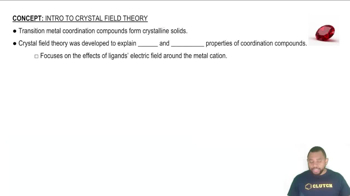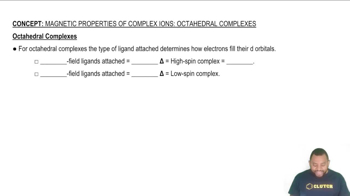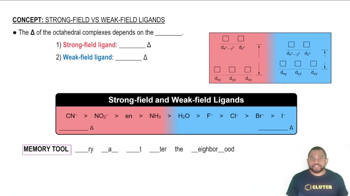Here are the essential concepts you must grasp in order to answer the question correctly.
Crystal Field Theory
Crystal Field Theory (CFT) explains how the arrangement of ligands around a central metal ion affects the energy levels of its d orbitals. In an octahedral complex, such as [Ru(NH₃)₅(H₂O)]²⁺, the d orbitals split into two energy levels: the lower-energy t₂g and the higher-energy e_g. This splitting is crucial for determining the electronic configuration and magnetic properties of the complex.
Recommended video:
The study of ligand-metal interactions helped to form Ligand Field Theory which combines CFT with MO Theory.
Low-Spin vs. High-Spin Complexes
Low-spin and high-spin complexes refer to the arrangement of electrons in the d orbitals of transition metal complexes. Low-spin complexes, like [Ru(NH₃)₅(H₂O)]²⁺, occur when the ligand field is strong enough to pair electrons in the lower energy orbitals before occupying the higher ones. This results in fewer unpaired electrons and typically leads to a diamagnetic complex.
Recommended video:
For octahedral complexes, Weak-Field Ligands create High-spin complexes and Strong-Field Ligands create Low-spin complexes.
Ligand Field Strength
Ligand field strength is a measure of the ability of a ligand to split the d orbital energies of a metal ion. Strong field ligands, such as NH₃, cause a significant splitting of the d orbitals, favoring low-spin configurations. In contrast, weak field ligands lead to smaller splitting and can result in high-spin configurations, influencing the overall stability and reactivity of the complex.
Recommended video:
Strong-Field Ligands result in a large Δ and Weak-Field Ligands result in a small Δ.
 Verified step by step guidance
Verified step by step guidance

